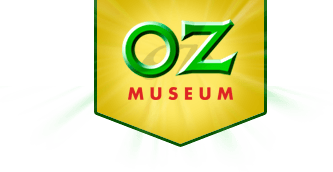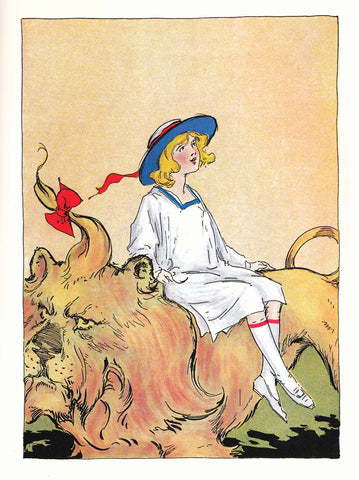 VISIT
MUSEUM STORE
MEMBERSHIP
OZ NEWS
CONTACT
VISIT
MUSEUM STORE
MEMBERSHIP
OZ NEWS
CONTACT
AT LEAST NBC GOT IT RIGHT THE FIRST TIME: THE 1933-34 OZ RADIO SHOW!
Wamego #79 Jan 20, 2017

[Above: Original John R. Neill illustrations of the Scarecrow and the Tin Woodman were adapted for these Jell-O advertisements and served as promotional tie-ins for THE WIZARD OF OZ radio series of 1933-34.]
NBC’s new television program, EMERALD CITY, has most definitely been a talking point among Oz fans these past several weeks, and both personal and professional reactions to the ten-part, limited series are -- to put it politely – “mixed.” (ENTERTAINMENT WEEKLY magazine coined my own favorite of the reviews when they succinctly opined, “EMERALD CITY: where Toto's a police dog, Munchkins are barbarians, and there's no place like literally any other channel.”) However, whatever its pros, cons, plusses, minuses, advocates, or detractors, NBC’s EMERALD CITY provides a happy reason to look back at the network’s FIRST amalgam of Oz and electronic entertainment. If of its time, their 1933-34 radio program made a genuine contribution to the greater legend and saga.
THE WIZARD OF OZ series ran from September 25, 1933, through March 23, 1934, and was commercially sponsored by Jell-O. There were three fifteen-minute programs every week, broadcast “live” from New York City on Monday, Wednesday, and Friday at 5:45 p.m. EST; each segment was accompanied by original music, composed and conducted by Frank Novak, who led the four-piece aggregation of musicians. By the time the show premiered, at least twenty-six major NBC affiliates across the Eastern and Midwestern United States had contracted to carry it.
There ultimately were seventy-seven episodes in all. During that arc, NBC’s writers managed to more-or-less adapt six of L. Frank Baum’s original books -- THE WONDERFUL WIZARD OF OZ, THE MARVELOUS LAND OF OZ, OZMA OF OZ, DOROTHY AND THE WIZARD IN OZ, THE ROAD TO OZ, and THE EMERALD CITY OF OZ; they also incorporated a few plot elements and personalities from THE SCARECROW OF OZ. The programs were liberally laced with Baum’s gentle philosophy, i.e., the Scarecrow sought a brain but was forever devising solutions to problems; the Tin Woodman was tender and thoughtful, despite his lack of a heart; the Cowardly Lion invariably summoned up the nerve to confront any threatening danger. Additionally, and whatever their challenges, the Ozians never failed to find a happy ending, and good triumphed over evil. (Per the script: Thus must it always be.)
The scenarists further integrated many twists, transpositions, and interpolations of their own to pepper the tales with slapstick, rhymed communicative (or spell-evoking) couplets, and cliffhanger moments – one of those at the conclusion of each and every episode! They linked the individual books as one continuous and ongoing adventure; in one such transition, Dorothy and Toto briefly met Tip before the girl and her dog returned to Kansas, thus effecting a segue from the escapades in THE WONDERFUL WIZARD OF OZ to those in THE MARVELOUS LAND OF OZ. Some of the scripts featured new, non-Baum locales, among them the River of the Rubber Ducks, the Land of Perpetual Night, the Land of Constant Day, the Land Where Wishes Come True, the Cave of the Winds, and a sea of glue. Auditors additionally met such previously unrecorded denizens as the Umbrella People, the Furious Frogs, and the Fearful Fish.

[Above (left): Nancy Kelly and Parker Fennelly are informally garbed as Dorothy and The Tin Woodman in this 1933 publicity pose for the Jell-O program. Of course, there was no need for them to be costumed while actually broadcasting, (Right) More than three decades before her unforgettable posturing as Endora on ABC-TV’s BEWITCHED (1964-1972), Agnes Moorehead was highly respected for her radio personations, including at least five Ozians during the Jell-O season. One of these characters – Mombi the Witch – returned to her repertoire when she appeared in the 1960 NBC-TV adaptation of THE LAND OF OZ, starring Shirley Temple.]
Twelve-year-old Nancy Kelly won the role of Dorothy – then promoted as “the biggest child part on radio” -- and briefly appeared as General Jinjur, as well. She later made a quantum leap to Broadway and Hollywood immortality as suicidal mother Christine Penmark in the stage and film adaptations of THE BAD SEED. Parker Fennelly voiced the Tin Woodman, the Sawhorse, and Tik-Tok, all prior to his later stint as Titus Moody on Fred Allen’s radio show, as well as a long-term sojourn as the Pepperidge Farm spokesman on TV commercials. Ian Wolfe contributed to hundreds of radio and TV shows and motion pictures and is probably best remembered as the pastor in SEVEN BRIDES FOR SEVEN BROTHERS and Mr. Neely of Disney’s POLLYANNA. Over NBC, he was Ozzily heard as the Wizard, the Braided Man, the Musiker, the leader of the Whimsies, a Rabbit Warbler, a Growleywog, and a camel. Ben Grauer served as OZ emcee and announcer and segued in and out of the story and Jell-O commercials in best wireless fashion. Most recognizable of the cast today, however – thanks to all those tele-seasons on BEWITCHED – would be Agnes Moorehead, then-thirty-two-years old and alternately speaking for Mombi, Princess Langwidere, the Queen of the Scoodlers, a snowbound cow, and a witch.
Each installment began with Grauer’s ominous pronouncement, “Jell-O brings you THE WIZARD OF OZ!,” followed by a brief reintroduction of the current Ozites, the story line, and (naturally) a plug for the sponsor. The major commercial was reserved for the concluding moments of the program, as the actors – still in character – commended the dessert. Dorothy, for example, found Jell-O to be “swell.” Suggestions were made for the creation of an “Emerald City mold” of lime green Jell-O, and on another occasion, it was offered that the fearsome dragonettes of the fourth series book should cultivate an appetite for Jell-O rather than citizens of Oz.
Across those six months, listeners (and collectors) also were thrilled by Jell-O’s “premiums”: four of Baum’s six LITTLE WIZARD STORIES OF OZ (1913), repackaged as paperbacks and including -- amidst the original John R. Neill drawings -- Oz-related plugs for the product. The titles were offered one-per-month from October through January and included “The Scarecrow and the Tin Woodman,” “Jack Pumpkinhead and the Sawhorse,” “Tik-Tok and the Nome King,” and “Ozma and the Little Wizard.” Alternately available for three Jell-O package fronts, one Jell-O package front, or a postcard, all four booklets finally were distributed in return for four Jell-O package fronts in March.

[Above: A Neill Jack Pumpkinhead and a Neill Tik-Tok also were redrawn to (charmingly) hawk the sponsor’s product. Those two characters, introduced respectively in the second and third Baum Oz books, were represented in several of the Jell-O radio programs.]
On March 23, 1934, Nancy Kelly and the other actors closed their network run with love and kisses from the Land of Oz, along with the hope that they’d soon be back. By that autumn, however, Jell-O had cast its commercial lot with an evening comedy program, and for the next eight seasons sponsored Jack Benny and his radio family. (Benny’s periodic opening greeting to his rabid listeners: “Jell-O again!”)
Unfortunately, there are no known recordings of any of these “live” OZ programs. But the surviving scripts, photographs, and clippings from those twenty-six weeks indicate that the NBC/Jell-O radio road to Oz did, indeed, provide happy, spirited, uplifting entertainment -- and a legitimate introduction to Baum’s characters and countries -- for countless thousands of children.
Article by John Fricke



